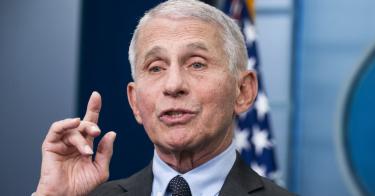House of Representatives investigators just issued an interim report on Tuesday detailing a sophisticated effort by leaders at the National Institutes of Health and a select group of researchers—including those who had received substantial NIH grant funding—to disprove the hypothesis that COVID-19 originated in a Chinese research laboratory and push the narrative that it instead emerged from nature.
Republican staff of the House Select Subcommittee on the Coronavirus Pandemic chaired by Rep. Brad Wenstrup, R-Ohio, have collected more than 8,000 documents, including emails and other communications, plus nearly 25 hours of witness testimony.
Their report details the January through March 2020 activities of Dr. Anthony Fauci and NIH Director Francis Collins in encouraging an international team of prominent scientists to attempt to debunk the notion that the pandemic could have originated in a lab.
The Means
Following a Feb. 1, 2020, conference call, Fauci and Collins “prompted” the scientists to act. According to the report:
Through its investigation, the select subcommittee has learned that Dr. Fauci and NIH exerted more influence over the conference call than previously disclosed. Further, by the end of the Feb. 1 conference call, Dr. Fauci had suggested the drafting of a paper regarding the potential of a lab leak to Dr. [Kristian] Andersen twice. This suggestion was what ‘prompted’ Dr. Andersen to draft ‘Proximal Origin.’
“Proximal Origin” refers to “The Proximal Origin of SARS-CoV-2,” the paper that ultimately was published in a scientific journal.
The end of this exercise was not a disinterested scientific effort, but rather an elaborate scheme to create a preferred political narrative that would dominate public discussion of the novel coronavirus. The means was publication in a high-powered, peer-reviewed professional journal that would discredit the “lab leak” theory.
Encouraged by Collins and Fauci, the authors submitted their initial draft to Nature, but the journal turned it down because the editors wanted a stronger dismissal of the lab leak theory. As Andersen testified to the subcommittee, “They thought that we came down too strongly on the side that the virus had been of possible lab origin.”
So, the authors revised their paper, adding language that the lab origin was implausible, and successfully submitted it to Nature Medicine, part of the Nature portfolio of journals. The finished product—titled “The Proximal Origin of SARS-CoV-2”—was published in Nature Medicine on March 17, 2020.
The Nature Medicine article, according to the subcommittee report, “is one of the single most impactful and influential scientific papers in history, and it expressed conclusions that were not based on sound science nor in fact, but instead on assumptions.”
Data Problem
In arguing for a natural or zoonotic (transferred from animals to humans) origin of the pandemic, the fact that SARS-CoV-2 had certain genetic features not found in previous coronaviruses was a problem, but an even greater difficulty was the absence of hard data. On Jan. 3, 2020, Communist Chinese authorities shut down the sharing of any COVID-19 data or information without government approval.
As noted in a Senate staff report sponsored by Sen. Marco Rubio, R-Fla.:
Scientists have not yet succeeded at tracing the origin because they have been denied access to the data that would facilitate a retrospective study of its genomic epidemiology. The epidemiological data released by the Chinese Communist Party (CCP) appears to have been curated to create an informational maze that leads to perpetual puzzlement.
Therefore, none of the scientists engaged by Fauci or Collins in February 2020 had, or could have had, access to any hard Chinese data on the novel coronavirus—especially information of an intermediate animal host—that could have proven, or at least strongly supported, the Chinese-endorsed narrative of the zoonotic or natural origin of the pandemic.
Several potential candidates for the intermediate animal host, including pangolins and raccoon dogs, have been floated; but to this day, no such host has been identified.
Numerous emails among the multiple authors during the Nature Medicine article’s drafting in February 2020 are especially revealing. Dr. Robert Garry of Tulane University, for example, initially expressed the view that the virus could have been genetically manipulated in a lab. Based on a previous select subcommittee report, he was not alone among this group of virologists in his initial impressions.
According to this week’s subcommittee report, Andersen, of Scripps Research Institute, who completed the initial draft, admitted in an email on Feb. 8, 2020:
Our main work over the last couple of weeks has been focused on trying to disprove any type of lab theory, but we are at a crossroad where the scientific evidence isn’t conclusive enough to say that we have high confidence in any of the three main theories considered.
In a Feb. 11 email, Dr. Ian Lipkin of Columbia University said the paper provided a “plausible argument against genetic engineering,” but it did not close the door on an “inadvertent release” of the virus from the Wuhan lab. It stated:
Given the scale of the bat Cov [a wide range of bat-borne coronaviruses] research pursued there and the site of its emergence of the first human cases, we have a nightmare of circumstantial evidence to assess.
Then again, on Feb. 20, Andersen—seemingly struggling with the task of refuting a lab origin conclusively—admitted in an email, “We all really, really wish we could do that (that’s how this got started), but unfortunately, it’s just not possible given the data.”
So, in the absence of scientific data, Andersen and his team proposed a theoretical construct of how SARS-CoV-2 emerged in nature.
Motives
Future congressional inquiries into this controversy should, of course, focus on the motivation behind this extraordinary effort to disprove the lab leak theory.
Based on the email exchanges among the key participants, this little platoon seemed inordinately obsessed with maintaining good relations with Communist China. In a Feb. 2 email, Dr. Andrew Rambaut of the University of Edinburgh wrote:
Given the s— show that would happen if anyone serious accused the Chinese of even accidental release, my feeling is we should say that given there is no evidence of a specifically engineered virus, we cannot possibly distinguish between natural evolution and escape, so we are content with ascribing it to natural process.
Scientists must keep their priorities in order, emphasized Dr. Ron Fouchier, a Dutch virologist: “Further debate about such accusations [of a lab leak] would unnecessarily distract top researchers from their active duties and do unnecessary harm to science in general and science in China in particular.”
Collins, the NIH director, echoed these sentiments, saying that without a case for COVID-19’s natural origins, ”the voices of conspiracy will quickly dominate, doing great potential harm to science and international harmony.”
In short, the email traffic follows the politics.
Concerning Fauci, the subcommittee report simply recounts that he knew at the time, or should have known, that his agency had funded EcoHealth Alliance, a firm engaged in “dangerous experiments” with the Wuhan Institute of Virology; that these coronavirus research activities were conducted with “very little oversight”; that EcoHealth Alliance was not in compliance with the federal government’s grant requirements and failed to report on its work in a timely fashion; and that the Wuhan Institute’s biosafety levels were “substandard”—a fact recently confirmed by the director of national intelligence. Congressional investigators will surely need to probe Fauci’s memory of these matters.
Though the hypothesis of a lab leak as the origin of a pandemic that has killed more than 1.1 million Americans is no longer dismissed today as a “conspiracy theory,” the damage to democratic discourse has been done.
The Nature Medicine article became the seminal scientific paper that drove the dominant narrative of COVID-19’s natural origins for the past three and half years. It also provided the strongest justification to marginalize alternative scientific opinion.
That corrosive impact on public discourse was itself a scandal. As New York Times columnist Bret Stephens observed: “The reasons for this—rank partisanship and credulous reporting—and the methods by which it was enforced—censorship and vilification—are reminders that sometimes the most destructive enemies of science can be those who claim to speak in its name.”
Editor’s note: This article was updated on March 25, 2024, to correct the excerpt from Dr. Kristian Andersen’s email of Feb. 8, 2020.
This piece originally appeared in The Daily Signal




